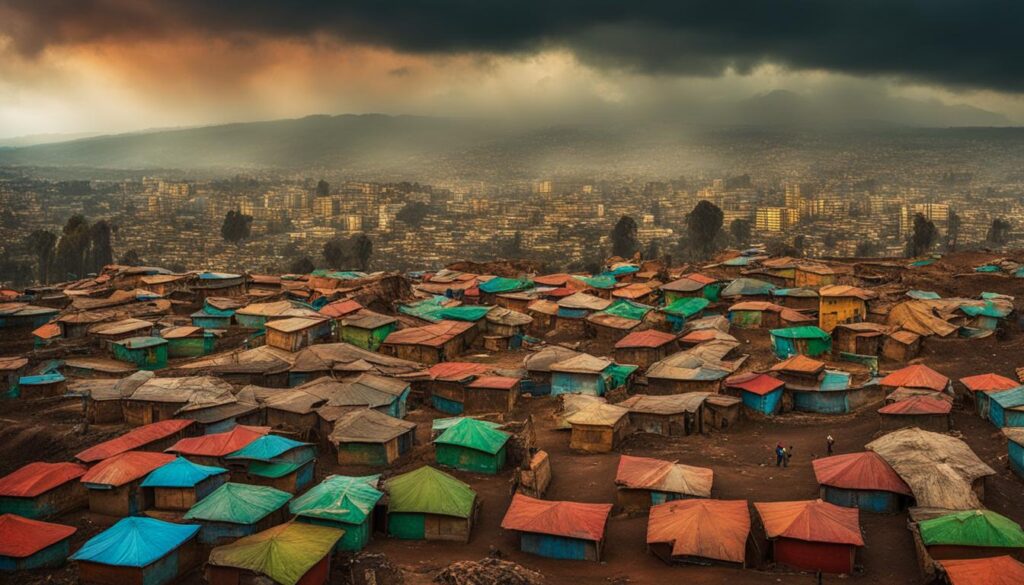How Cold Does It Get in Addis Ababa?
When it comes to Addis Ababa, the capital city of Ethiopia, many people assume that it must be sweltering hot year-round due to its location in Africa. But is this really the case? What if we told you that Addis Ababa actually experiences a cool climate? Yes, you read that right! Addis Ababa’s temperature may surprise you with its coldness, even though it’s situated closer to the equator.
So, how cold does it really get in Addis Ababa? Let’s uncover the truth about the city’s climate and explore the temperature variations throughout the year.
Key Takeaways:
- Addis Ababa enjoys a cool and comfortable climate due to its elevated plateau location.
- The city experiences temperature variations ranging from 48°F to 75°F throughout the year.
- The warm season from February to June sees the highest temperatures, while August is the coldest month.
- The temperature remains relatively mild compared to other parts of Ethiopia.
Best Times to Visit Addis Ababa
If you’re planning a trip to Addis Ababa, the capital city of Ethiopia, it’s important to consider the best times to visit for optimal weather and enjoyable outdoor activities. The city boasts a cool and comfortable climate throughout the year, but there are certain periods when the weather is especially favorable.
The ideal times to visit Addis Ababa for warm-weather activities are from mid-May to early June and from late September to early April. During these months, the weather is pleasant, with temperatures ranging from the mid-60s to the low 70s Fahrenheit.
The dry season, which occurs from November to February, is particularly recommended for a visit to Addis Ababa. During this time, you can expect clear skies, low humidity, and plenty of sunshine. It’s the perfect opportunity to explore the city’s attractions, embark on outdoor adventures, and engage in warm-weather activities.
It’s essential to keep in mind that while the days may be warm and pleasant, the nights can get chilly. Nighttime temperatures can drop as low as 40°F, so make sure to pack warm clothing to stay comfortable. Layering is always a good idea to adjust to temperature fluctuations throughout the day.
Whether you plan to discover the rich cultural heritage of Addis Ababa’s museums and historical sites, indulge in the vibrant local cuisine, or explore the stunning natural surroundings, visiting during the recommended times will enhance your experience and allow you to make the most of your time in this charming city.
Climate Variations in Different Regions of Ethiopia
Ethiopia’s climate shows significant variations across different regions, primarily due to differences in elevation. While Addis Ababa experiences a cool and mild climate, other areas of the country can have distinct weather conditions.
The Northern Highlands: Places like Lalibela and Bahir Dar, located in the Northern Highlands, have cooler and wetter climates compared to Addis Ababa. The rainy season in these regions typically occurs from July to August, with increased rainfall.
The Eastern and Southern Regions: On the other hand, regions like the Omo River Region in the east and south tend to have hotter and drier climates. Temperatures in these areas often exceed 85°F, making them relatively warmer compared to other parts of Ethiopia.
Understanding these regional variations is essential when planning a trip to Ethiopia. Depending on the specific regions you plan to visit, it’s crucial to be prepared for the different climates and pack accordingly.
Weather Conditions in Specific Cities of Ethiopia

Different cities in Ethiopia have their own climate characteristics. When planning a visit to Ethiopia, it’s important to consider the climate of specific cities. Let’s explore the weather conditions in some key cities:
Addis Ababa
Addis Ababa, the capital of Ethiopia, experiences cool temperatures and relatively consistent weather throughout the year. Situated on an elevated plateau, the city enjoys a mild climate with average temperatures ranging from 48°F to 75°F. This makes Addis Ababa an ideal destination for those seeking comfortable weather conditions.
Mekele
Mekele, located in the north of Ethiopia, shares similar temperature patterns with Addis Ababa but receives less rainfall. Visitors to Mekele can expect cool temperatures, making it a great place to explore historical sites and cultural attractions without extreme heat.
Dire Dawa
Dire Dawa, situated in the east of Ethiopia, has a lower elevation, which results in considerably warmer temperatures compared to Addis Ababa. During the hottest months, temperatures in Dire Dawa can exceed 95°F. If you enjoy warmer climates, Dire Dawa offers a different experience.
Each of these cities offers a unique climate, reflecting the diversity of Ethiopia. Whether you prefer cooler temperatures in Addis Ababa, milder conditions in Mekele, or the warmth of Dire Dawa, considering the climate of specific cities will help you plan your visit to Ethiopia accordingly.
Rainy Season vs. Dry Season in Ethiopia

Ethiopia experiences distinct rainy and dry seasons throughout the year. The rainy season typically starts in April and lasts until September, although the intensity and duration vary across different regions. In the northern part of the country, July and August witness the highest rainfall, while the southern regions experience peak precipitation during April, May, and October. These weather patterns can have an impact on travel, particularly on overland routes that may suffer from flood damage. To ensure a smooth and enjoyable trip, it is essential to plan your visits accordingly.
What to Pack for Different Season in Ethiopia
When visiting Ethiopia, packing appropriate clothing for different seasons and regions is essential to ensure comfort throughout your trip. The country experiences distinct wet and dry seasons, each with its own unique weather conditions. Whether you’re exploring the northern or southern regions, it’s important to be prepared for the local climate.
Wet Season:
In the wet season, particularly in the northern and southern regions of Ethiopia, it is advisable to pack clothing that will keep you dry and protected from the rain. Consider packing the following items:
- Sturdy, waterproof shoes to navigate through wet and muddy terrain.
- A windproof jacket or raincoat to stay dry during unexpected downpours.
- Layers of clothing to adjust to temperature changes throughout the day.
Dry Season:
During the dry season, it is important to pack lightweight and loose-fitting clothing to combat the heat. Although temperatures may rise, shorts are generally not appropriate in Ethiopia, as the local culture tends to favor modesty. Ensure you pack the following items:
- Lightweight, breathable clothing made from natural fabrics to keep you cool.
- A hat to protect your head and face from the sun.
- Sunscreen and a pair of sunglasses to shield your skin and eyes from harmful UV rays.
By packing accordingly for different seasons in Ethiopia, you’ll be well-prepared to enjoy your trip and explore the diverse landscapes and cultures the country has to offer.
Optimal Times to Avoid Crowds and Extreme Weather in Ethiopia
To have a pleasant and crowd-free experience while planning a visit to Ethiopia, it is best to consider the optimal times to avoid crowds and extreme weather conditions. The shoulder seasons, which occur from November to February and April to May, are ideal for avoiding crowds and enjoying comfortable weather.
During these months, the weather in Ethiopia is generally pleasant, making it a great time to explore the country’s rich culture and natural beauty. Additionally, tourist attractions are likely to be less crowded, allowing for a more enjoyable and immersive experience.
However, it is important to note that while these periods offer favorable conditions in most regions, specific areas may still experience variations in weather. To ensure you are well-prepared, it is advisable to check localized weather reports before traveling to Ethiopia.
By planning your visit during these optimal times, you can avoid crowds and extreme weather conditions, maximizing your enjoyment of this beautiful country.
Conclusion
In conclusion, Ethiopia offers a diverse climate that appeals to a range of travelers. Whether you’re seeking cool temperatures or warm-weather activities, this country has something for everyone. Addis Ababa, with its cool and comfortable climate year-round, is an ideal destination for those who prefer pleasant weather throughout their visit.
The best time to visit Addis Ababa is during the dry season from November to February. During this period, you can expect clear skies and comfortable temperatures, making it perfect for sightseeing and outdoor exploration. However, it’s important to consider the climate of specific cities and regions when planning your visit to Ethiopia.
Different cities in Ethiopia have their own unique climate characteristics. From the cooler temperatures of Mekele to the warmer climate in Dire Dawa, each city offers a distinct experience. Therefore, it is crucial to pack accordingly and be prepared for varying weather conditions.
In conclusion, when visiting Ethiopia, it’s important to research and plan your trip based on the specific climate of the region you wish to explore. By doing so, you can ensure a comfortable and enjoyable experience, avoiding extreme weather conditions and unnecessary inconveniences. So, pack your bags, embrace the diversity, and embark on an unforgettable adventure in Ethiopia.







